How to properly and than close the radiator
Using decorative grilles and screens suitable for the interior of the room, you can hide the massive cast-iron radiators from the eyes. This allows to obtain the necessary aesthetic conformity of the room to the planned repair. In addition, such structures also perform practical work, protecting children in institutions from possible injury.
The industry offers a wide range of similar products, so today our task is to help you choose the right one. Most often for office and residential premises they choose inexpensive plastic screens that produce a wide range of colors, which facilitates the selection of the interior. In state institutions are allowed only products made from natural wood.

Kinds
When choosing how to close the radiator, most often buyers pay attention to screens and decorative grilles, which have their own design features. You can divide them into the following groups:
| Hinged | May be with or without covers. Designed for masking cast iron radiators placed in a niche under the windowsill or slightly protruding. Their price depends on the size of products. |
| Flat | Apply to fencing batteries installed in deep niches. |
| Attachments | Used to completely hide the installation location of the heater. |
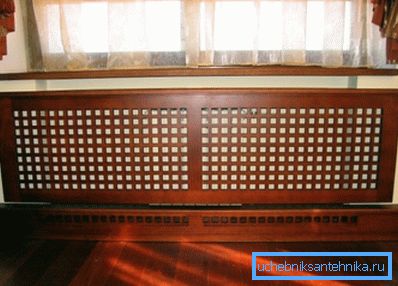
Make such products from:
- metal;
- plastic;
- wood;
- MDF;
- glass
False wall or plasterboard box
Most of us during the repair want to remove not only the batteries from the eyes, but also the supply pipes to them. The latter also do not normally make a false ceiling or floor covering. In this case, the entire connection with the radiators is often hidden behind the false wall of drywall.
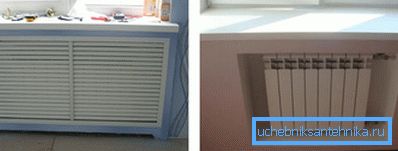
Tip: be prepared that in case of emergency you will have to break all the “beauty”, therefore we recommend to make a false-wall quick-release.
Instead, it is possible to install a duct for pipes made of gypsum boards if every centimeter of useful area is important in a room. Below you will learn how to close the heating radiator with drywall yourself.

- Prepare materials and tools:
- pencil;
- roulette wheel;
- building level;
- scissors for metal;
- screwdriver;
- dowels and screws;
- UD and CD profile;
- drywall;
- decorative lattice.
Tip: if you do not know how to close the heating pipes, you can also use the GCR.
- Make a frame of the metal profile to mask the radiator installed in the niche, around the perimeter of this recess. Create a single frame using the UD guide profile, which must be attached to the bottom of the sill, to the walls and floor with self-tapping screws.
Tip: note that you are using wall gypsum board with a thickness of 12.5 mm, so the front of the frame must be recessed by 13 mm in order to get a level surface with the wall after installation.
Insert into the resulting frame vertically on both sides of the radiator profile CD. Make sure that the distance between them is slightly larger than the size of the decorative grid.
After that, interconnect the vertical CD-profiles with 4 segments of the UD-profile with a length of 60 mm. And cut off the open side of the device to the heating. They will form the basis for horizontal profiles denoting the height of the decorative frame. If necessary, install additional vertical CD profiles every 600 mm.
- Use your hands to sew up the frame with drywall sheets and putty. After that, hang a decorative grille. Attach the profiles to each other with small-sized LM-screws.
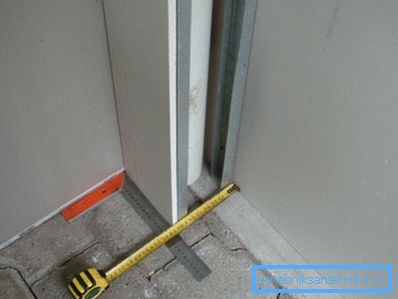
The advantages of decorative grids
- The amount of dust settling on batteries, which have a complex shape for cleaning and washing, will decrease.
- Large selection of protective screens suitable for the interior of the room in style and material of manufacture.
- They will be able to protect young children from injury when falling on metal heating devices. In addition, you can not be afraid that the child will be burned by touching them.
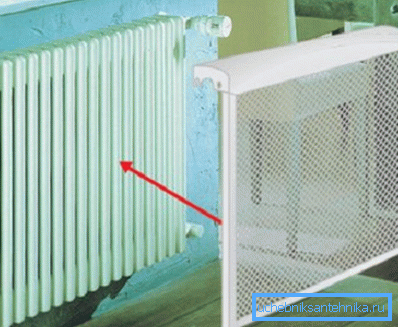
- The practicality of the equipment - it provides an even distribution of warm air flow in the space of the room.
- You can hide old cast-iron batteries in a short time, which by their appearance only spoils the interior of the newly renovated room.
There is another opinion of experts who do not deny the beauty of the products and their contribution to the general atmosphere of the room, at the same time they believe that the heat transfer of equipment is significantly reduced in this way. At the same time, this is easily refuted by the practice of operating such gratings and screens that do not prevent the heat from escaping through their openings.
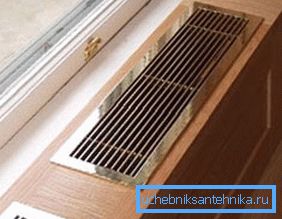
Before you close the radiator or decorate it, find out the recommendations of professionals:
- Do not completely cover the path of convection air flow. As a result, the temperature in the room will decrease, and condensation will appear on the windows.
- Prefer easily removable design or with a window, which provides quick access to pipe threads and batteries.
- The instruction obliges to provide access to adjusting components - cranes and thermal heads.
Conclusion
In the new interior, the old heating radiators do not look aesthetically pleasing; therefore, to conceal them, special decorative screens and grilles have been developed, which are made of different materials. In addition, the battery can be closed with the help of gypsum sheets installed on a metal frame.
In any of these cases, it is necessary to take care of free access to circulating air heating devices, as well as their quick dismantling in case of an accident. The video in the article will help you find additional information on this topic.